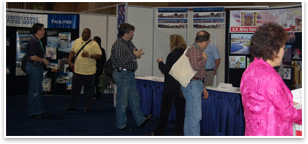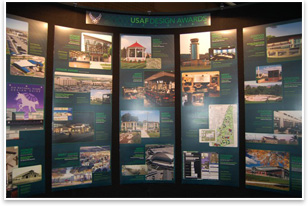
|
Members Connect with Federal Agencies at Expo2007 How do you . . . tap into the federal market?
Speck says the agency works hard to match the firm and firm philosophy with the specific project. It’s one of the few clients, he said, that does not require the architect to have done another building of the type: “They assume you can get consultants.” He also noted that there is some preference given to firms in the project region. But in the first round of the request for proposals, he said, the GSA is most interested in finding a lead designer, and is “willing to fill in many of the details once that selection is made.”
Tips for federal procurement
Sorg offered her insights on federal procurement with these 10 suggestions. Getting the first project
Keeping the work
Stepping up and competing with the big boys (and girls)
|
||
Copyright 2007 The American Institute of Architects. All rights reserved. Home Page |
||
home
news headlines
practice
business
design
Recent related
› See The AIA Angle for more Government Advocacy news
› GSA Building Modernization: Design Excellence and LEED Gold Certification
› Adapting Standard Embassy Design to Specific Sites (PDF)
The AIA Government Advocacy team suggests these online resources:
• AIA Guide to Federal Procurement
• U.S. General Services Administration
• FedBizOpps, the single government point-of-entry for federal government procurement opportunities over $25,000
• FirstGov, the federal government's official Web portal, which contains links to GSA schedules, GSA publications for small business, and more.
Did you know…
Where some of those federal design and construction dollars go? The federal portfolio includes owning or leasing nearly:
• 340 million square feet of office space in 2,000 U.S. communities
• 37,000 post offices
• 165 border stations
• 160 hospitals
• 800 outpatient clinics
• 130 nursing homes
• 15,000 diplomatic missions on 6 continents and 24 time zones.
The federal government is a reliable client, says Andrew L. Goldberg, Assoc. AIA, manager, Federal Affairs. “As someone once put it,” he said, “‘if the federal government goes out of business, getting paid will be the least of your worries.’”

 Summary:
Summary: Speck, whose firm Page Sutherland Page, Austin, is working with the General Services Administration on three Design Excellence projects, said he is impressed “over and over again” with the program. He praises it as well run, and sees the GSA’s Office of the Chief Architect a conduit for promoting good, sustainable design among its own client agencies. He says the agency, which manages projects ranging from the smallest border station to the largest federal courthouse, sees their buildings as symbols of a nation and assets for their communities.
Speck, whose firm Page Sutherland Page, Austin, is working with the General Services Administration on three Design Excellence projects, said he is impressed “over and over again” with the program. He praises it as well run, and sees the GSA’s Office of the Chief Architect a conduit for promoting good, sustainable design among its own client agencies. He says the agency, which manages projects ranging from the smallest border station to the largest federal courthouse, sees their buildings as symbols of a nation and assets for their communities. Sorg and her firm Sorg and Associates, has produced award-winning architecture for the U.S. State Department. The small practice takes advantage of proposal requests and Sorg is tenacious about tracking down federal work, often following a project for many years from the rumor-mill through the request for proposals.
Sorg and her firm Sorg and Associates, has produced award-winning architecture for the U.S. State Department. The small practice takes advantage of proposal requests and Sorg is tenacious about tracking down federal work, often following a project for many years from the rumor-mill through the request for proposals.